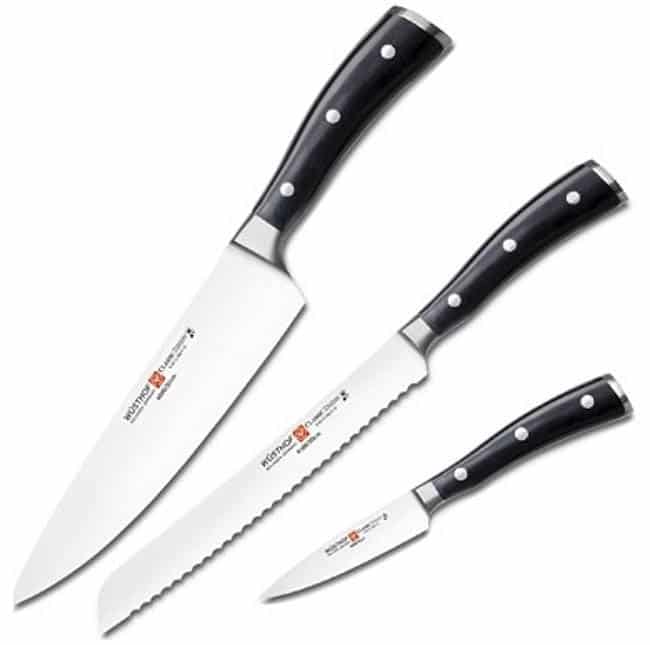Domestic Details: The 3 Knives You Need in Your Kitchen
This post may contain affiliate links. Read about my affiliate policy.

For better of for worse, knives are your most important tools in the kitchen. And while most of you probably own several knives, I’ve recently realized that many of you may be “confused” when it comes to using them. I have witnessed friends tear meat with a serrated knife, crush tomatoes with a blunt chef’s blade, and chop vegetables with a boning knife, and while it’s upsetting to watch, I realize that it’s not really their fault. Many peeps don’t know what knives to buy, while others just purchase a whole fancy knife set that they don’t know how to use, which is equally problematic.
In the hope of clearing up this knife confusion, I would like to shed some light on the knives that you actually need in your kitchen and what each of them is used for. Knowledge bomb: Almost any culinary pursuit can be accomplished using only the three knives listed below.
The 3 Knives You Need in Your Kitchen:
1. Chef’s Knife- Usually about 8 inches long and 1½ inches wide, this knife is your general utility tool. The chef’s knife is used for a variety of purposes, especially mincing, slicing and chopping vegetables and meat. It is definitely the most frequently used knife in any kitchen, so take some time to get comfortable wielding this bad boy. Please be aware of your fingers and always use a cutting board.
2. Serrated Knife- This knife has a scalloped, tooth-like edge that works like a miniature saw. The knife’s teeth catch and rip as it slices cleanly through the food, making it ideal for slicing things that have a hard exterior and a soft interior that can be easily crushed. Use your serrated knife to slice crusty bread, tomatoes (please never use any other blade on a tomato), citrus fruit, and layer cakes. Serrated knives come in a variety of sizes, but you should be able to accomplish most tasks with a mid-size one. Please be extra careful with this knife, peeps. Serrated cuts are not pretty.
3. Paring Knife- Think of this knife as your precision tool. Usually between 2.4 and 4 inches in length, this little guy is ideal for more detail-oriented tasks such as peeling fruits and vegetables, slicing a single clove of garlic or a shallot, sectioning citrus fruit, and scoring or cutting shapes in dough. The small handle gives you lots of control over the blade, so you can use it while holding it aloft as well as on a cutting board.
*Note: Do not confuse a classic paring knife with a “bird’s beak” style paring knife. The latter is primarily used for decorative cuts, so unless you plan to flute mushrooms or make rosette radishes on the reg, please stick with the classic version.
While most knives that you’ve encountered have probably been of the steel variety, I would highly suggest giving ceramic a shot. You want to be working with the sharpest knives possible at all times, and steel knives tend to dull rather quickly. In case you’re unaware, dull knives are both inefficient and dangerous. (The sharper the knife, the less you cry, etc.) So unless you feel comfortable sharpening your own knives (which makes me nervous), ceramic is the way to go. Ceramic knives require no sharpening, and they are very lightweight, which is great news, since chopping with a heavy chef’s knife is totally exhausting. Plus, they are affordable and come in a variety of sassy colors. Sweet.
When it comes to washing and storing your knives, please heed the following two rules:
1. Do NOT put them in the dishwasher. I know it’s tempting to throw them in with everything else, but the water pressure will dull your knives incredibly quickly (even the ceramic ones), and the knives’ blades may chip/scratch your other fancy dishware. Suck it up and hand wash them with a soapy sponge. (Carefully. Duh.)
2. Do NOT store your knives loose in a drawer. Keeping a bunch of ridiculously sharp object randomly mixed in with other kitchen items is a ridiculous idea. Get a knife block, a magnetic strip, or a drawer insert that’s designed to hold knives. No excuses.
Domesticity is all in the details, friends. Bow to your sensei.
*If you have a burning question that you’d like featured on a future edition of Domestic Details, don’t hesitate to contact me or leave it in the comments. Help me help you.
Shop this post
Never miss a post!
Get new recipes and lifestyle tips delivered straight to your inbox.
